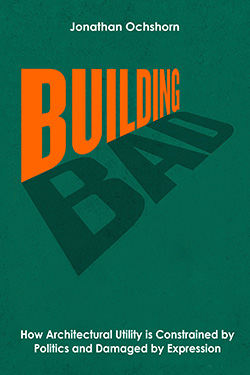Ordering options:
Contents:

I. Dysfunction and Inflexibility
1. Opening Remarks on Function and Flexibility
4. Privacy and Control: Lighting and Acoustics

19. Opening Remarks on Sustainability
24. Indoor Environmental Quality
OMA's Milstein Hall music video! | Check for errata in paperback edition (PDF, ePub, and web versions are always up to date).
This is a book about architectural failure. In addition to some general observations and an occasional digression, the heart of the book is a rather detailed examination of dysfunction, inflexibility, fire hazard, nonstructural failure, and unsustainable design in Milstein Hall at Cornell University, the flagship building designed by the Office for Metropolitan Architecture (OMA) for Cornell's College of Architecture, Art and Planning. The choice of Milstein Hall is both arbitrary and pragmatic: arbitrary because many other buildings might have served as case studies for the particular problems I enumerate; pragmatic because, as a member of Cornell's faculty since 1988, I have had special access to the building's planning, design, construction, and occupancy.
There are 26 chapters in the book organized into four parts—with each part corresponding to one category of architectural failure:
- Part I (Dysfunction and Inflexibility) includes detailed discussions of function, flexibility, privacy, lighting, acoustics, circulation, orientation, and access.
- Part II (Nonstructural Failure) offers an examination of thermal control, rainwater control, and sloppy, dysfunctional, and dangerous details in Milstein Hall.
- Part III (Fire Hazard) discusses the many ways in which Milstein Hall contravenes normative fire safety standards.
- Part IV (Unsustainable Design) is in equal part a critique of Milstein Hall's sustainability and the cynical use of the LEED Reference Guide as validation for Milstein Hall's "green" credentials.
Writing and researching my monograph, Building Bad: How Architectural Utility is Constrained by Politics and Damaged by Expression (Lund Humphries, 2021), provided a useful theoretical base for the present work, which is, in effect, a case study in "building bad." The competition driving dysfunctional modes of expression and the political calculations that effectively constrain durability and safety—both of which increase the probability of building failure—are theorized in Building Bad. And this theory applies to most avant-garde architecture, including the architecture of Milstein Hall. The present book does not rehash the underlying theoretical arguments for nonstructural failure that appeared in Building Bad; instead, it examines what such failure looks like in a single building—as a case study.
Similarly, there is no attempt in the present book to systematically link each instance of architectural failure in Milstein Hall to the theorizing of Rem Koolhaas and OMA-AMO. In a few instances, connections between the design of Milstein Hall and the architects' design philosophy are briefly noted: Bill Millard's explanation of inflexibility in the work of OMA is discussed in chapter 2. Contradictory attitudes toward large, interconnected spaces and atriums in Milstein Hall—based on Koolhaas's essay on "Junkspace"—are analyzed in chapter 6. Finally, Koolhaas's embrace of fiction and false facts in Delirious New York provides some context for the various "fictions" that show up in published commentary on Milstein Hall, enumerated in Chapter 7. But all these observations are incidental; this book is not intended as a comprehensive analysis of Koolhaas or his writing. Rather, my hope is that this book helps reorient architectural criticism away from subjective responses to form and expression, and toward more objective analyses of utilitarian functionality in buildings.
Jonathan Ochshorn is professor emeritus, Department of Architecture, at Cornell University, USA. He is a practicing architect and is author of Building Bad as well as the textbook Structural Elements for Architects and Builders.
Other open-access books by Jonathan Ochshorn:






